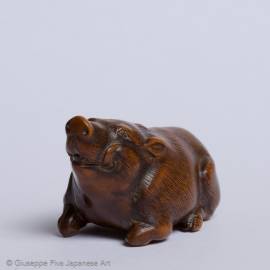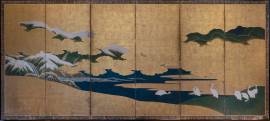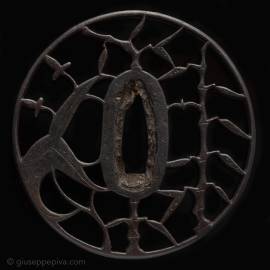Wooden netsuke with crouched boar19th centuryWooden netsuke Length: 4.5 cm The inoshishi (boar) is the twelfth sign of the Japanese zodiac. In Japan this animal is a symbol of courage because of its brave nature that brings him to never look back during fights and to rail against the enemy without flinching.Often described in Japanese mythology, the boar is represented here lying, with its muzzle raised and the ears backwards: he seems to have sensed the danger.Netsuke for sale. Price on application. Please include item stock number: net-1050 ...
WORKS FOR SALE
Rinpa SchoolEarly Edo period (1615-1867), 17th centurySix-fold screen; gold ground.169 x 376 cm The term ‘Rinpa’ is an amalgamation between the last syllable from ‘Kōrin’, name of the mayor exponent of this artistic movement, and the word pa, literally “school” or “group”. However, it is to say that this name was given only later, in the 17th century, when Kōrin (1658 – 1716) further developed the school’s style. Concretely it refers to the broadly teaching of Kōrin masters. The first promoters of the Rinpa style are identified...
Mumei, Edo Period, 17th CenturyIron, 8.1 x 7.9 x 0.5 cmNBTHK Hozon Tōsogu Specifications: Tatemarugata, tetsu-ji, ji-sukashi, kebori, kaku-mimi ko-niku The pierced design shows an omodaka plant among canes and a wild goose flying.Sagittaria water plantain (omodaka) first appeared as a design for tsuba in the Heian period. From such early beginnings, this decorative plant has shared a long history with the samurai. Also known as “shogun’s grass” (shogunso), it was held in high esteem as a symbol of victory.The tsuba comes with a Hozon Tōsogu certificate (fitting...
Copyright © 2016 - giuseppe piva - VAT: 05104180962










